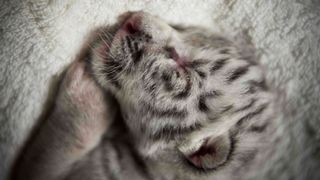Tigers: The world's largest cats
Tigers are at home in the tropics or in the snow.

Tigers are the largest members of the cat family and are instantly recognizable thanks to their striking orange and black stripes. These apex predators are capable of taking down prey of all sizes, from rodents to elephant calves.
Increasingly in recent decades, human activities such as poaching have pushed tigers to the brink. Their range in Asia is a tiny fragment of what it once was, and all remaining tiger populations are threatened with extinction.
Are tigers bigger than lions?
Tigers grow to between 6 and 10 feet (2 to 3 meters) long and weigh up to 660 pounds (300 kilograms), according to the World Wildlife Fund (WWF). Lions can reach similar body lengths as tigers, but lions are lighter, weighing up to about 550 pounds (250 kg), according to the Smithsonian's National Zoo.
No two tigers have the same markings, and like human fingerprints, their stripes are unique, according to the Wildlife Conservation Society. In the wild, tiger stripes act as camouflage to help the animals blend into their environment.
Related: Why are tigers orange?
Where do tigers live?
Wild tigers live in Asia. Most populations inhabit tropical regions in countries such as Thailand, India and Indonesia, but tigers can also be found in much colder environments, including in the far east of Russia, according to Panthera, a wild cat conservation organization. Tiger habitats include tropical forests, arid forests, flooded mangrove forests and taigas (cold forests with coniferous trees), according to the San Diego Zoo.
Tigers used to have a much larger range, but poaching, deforestation and other human activities have caused tiger populations and habitats to shrink. Today, scientists estimate that tigers occupy less than about 6% of the land they once did, according to the International Union for Conservation of Nature (IUCN).
What are the different types of tiger?
For many years, scientists separated tigers into nine subspecies, including six living subspecies and three extinct subspecies. The living subspecies were Bengal tigers (Panthera tigris tigris), Amur tigers (P.t. altaica), South China tigers (P.t. amoyensis), Sumatran tigers (P.t. sumatrae), Indochinese tigers (P.t. corbetti) and Malayan tigers (P.t. jacksoni).
Kingdom: Animalia
Phylum: Chordata
Class: Mammalia
Order: Carnivora
Family: Felidae
Genus and species: Panthera tigris
Source: ITIS
Humans wiped out the extinct tiger subspecies by hunting them and destroying their habitats. Bali tigers (P. t. balica) were last documented in the late 1930s, Caspian tigers (P.t. virgata) went extinct in the early 1970s and Javan tigers (P.t. sondaica) disappeared by the early 1980s, according to the IUCN Cat Specialist Group.
In recent years, some researchers have challenged the traditional tiger classification. A 2015 study published in the journal Science Advances argued that there are only two subspecies of tigers: Sunda tigers, which combined Sumatran tigers and extinct Bali tigers and Javan tigers into one subspecies under the name P.t. sondaica, and continental tigers, a subspecies that contains all other tigers under the Bengal tiger name P.t. altaica. However, a study published in the journal Current Biology in 2018 presented genomic evidence supporting the traditional classification of six genetically distinct subspecies of tigers
Related: The strange history of white tigers
Are white tigers natural?

The white tigers seen in some zoos are not a separate species or subspecies from orange tigers; rather, they are the result of a mutation in a single gene. A 2013 study published in the journal Current Biology found that a mutation in a pigment gene called SLC45A2 is responsible for stopping the production of red and yellow pigments that give normal tigers their color, resulting in tigers that are white with black stripes.
White tiger gene variations originate from the Bengal tiger population. However, the mutation is extremely rare in the wild, and the last known wild white tiger was hunted and killed in 1958. A white tiger that was captured in central India in 1951 and named Mohan is the ancestor of almost all white tigers in captivity today. Mohan's descendants were deliberately inbred by humans to increase the chances of passing on his mutation. This inbreeding led to a range of health problems in the white tiger population, including premature deaths, deformities and stillbirths, according to the 2013 study.
Humans can also selectively breed tigers in captivity to change the color of their stripes to make them lighter and more golden. A rare genetic variation can even cause tiger stripes to broaden and fuse together so that the tiger appears blacker than usual. This "black tiger" coat is also seen in one population of wild tigers in Similipal Tiger Reserve in eastern India, likely because the population is small and isolated, with limited genetic diversity, according to a 2021 study published in the journal Proceedings of the National Academy of Sciences.
What do tigers eat?
All tigers are carnivores, and most of their diet consists of large prey weighing 45 pounds (20 kg) or more, such as pigs and deer. They can also take down larger, more challenging prey, including elephant calves and leopards, according to SeaWorld.
To hunt their prey, tigers stalk an animal to get as close to it as possible without being seen and then launch a swift attack by sinking their teeth into the animal's neck. The tiger's canine teeth have pressure-sensing nerves, so it can feel where to deliver a fatal bite. Tigers are capable of eating more than 80 pounds (36 kg) of meat in a single sitting, according to the WWF.
A tiger's hind legs are longer than its front legs, allowing it to jump distances up to 33 feet (10 m), according to SeaWorld. Tigers also have retractable claws that extend up to 4 inches (10 centimeters) long and are used to grab and hold on to their prey.
Related: Hunters may lure 'man-eating' tiger with Calvin Klein's Obsession

How do tigers reproduce?
Tigers are solitary creatures and spend most of their time alone, roaming their massive territories. According to the San Diego Zoo, Amur tigers have the largest range, with individuals capable of having a territory of more than 4,000 square miles (10,300 square km). Tigers mark their territory in a variety of ways, such as scratching trees and leaving feces out in the open.
Male tigers can tell when a female is ready to mate by the scent of her urine. Tigers have a range of vocalizations they can use to communicate with other tigers, including roars and hisses, and a male and female will call to find each other. After mating, female tigers have a gestation period of about 100 days before giving birth to two to four cubs on average, according to the Smithsonian's National Zoo.
Life is dangerous for young tigers, and only about half of all cubs live longer than two years, the age at which they become independent, according to the WWF. Mothers must leave their cubs while they hunt, which means cubs are unprotected from predators. When tigers reach independence, they must then compete with other tigers for territory. Wild tigers usually have a life span of 10 to 15 years, but they occasionally live 20 years, according to the Smithsonian's National Zoo. The oldest tiger in captivity is more than 25 years old, according to Guinness World Records.
Related: Adorable clip of tiger cubs learning to wrestle will melt your heart on this 'Arctic' day
Why are tigers endangered?
The IUCN categorizes tigers as endangered and lists illegal poaching as the main threat to the species. Tigers are poached so their body parts and fur can be sold as part of the illegal wildlife trade. Tiger bones are used in traditional Asian medicines, and similar markets seek tigers' skin, teeth and other parts.
In addition to the threat of poaching, tiger habitat is being converted into agriculture or human settlements and commercially logged. Tiger attacks on humans and livestock also bring the big cats into conflict with people, who kill them in retaliation.
A 2013 study published in the journal Wildlife Biology in Practice found that tigers in the Sundarbans Reserved Forest region of Bangladesh killed an average of 22 people per year over a 63-year period. While the relative risk of a human being killed by a tiger in its range is low, such killings have a big impact on the families of the people who are killed and give tigers a bad reputation.

How many tigers are there?
There are fewer than about 3,900 tigers left in the wild, but the captive tiger population is much larger. According to the WWF, the U.S. alone has about 5,000 tigers in captivity. However, experts say that captive breeding won't be enough to save the dwindling wild tiger populations.
"The problem is not that tigers can't breed in the wild," Dale Miquelle, coordinator of the Wildlife Conservation Society (WCS) Tiger Program and director of the WCS Russia Program, previously told Live Science. "They are perfectly capable if they are provided with the minimum needs for survival — sufficient space, sufficient prey and protection from poaching."
Related: There are more 'pet' tigers than there are in the wild. How did that happen?
Accredited zoos such as those belonging to the Association of Zoos and Aquariums (AZA) strictly monitor animal breeding and raise money and awareness to support wild tiger research and conservation; however, only about 6% of the captive U.S. tigers are in AZA collections, Live Science previously reported. Many captive tigers are privately owned, as seen in Netflix's controversial "Tiger King" series.
Tigers don't make suitable pets. They require expert care, including appropriate nutrition and adequate space. Captive tigers also sometimes attack their owners or keepers. A 2013 study published in the journal Forensic Science International noted that most of the reported fatal or near-fatal tiger attacks have involved captive tigers.
Additional resources
To learn more about big cats and how they evolved, check out "The Big Cats and Their Fossil Relatives" (Columbia University Press, 2000). To see a tiger mother care for her cubs, watch this short YouTube video by BBC Earth. For more information about tiger conservation, check out the IUCN website, where you can read about their Integrated Tiger Habitat Conservation Programme.
Bibliography
Barlow, A. C. D., Ahmad, I., & Smith, J. L. D. (2013). Profiling tigers (Panthera tigris) to formulate management responses to human-killing in the Bangladesh Sundarbans. Wildlife Biology in Practice, 9(2). https://www.researchgate.net/publication/260158565_Profiling_tigers_Panthera_tigris_to_formulate_management_responses_to_human-killing_in_the_Bangladesh_Sundarbans
Evon, D. (2021, April 13). Is this a tiger with Down syndrome? Snopes. https://www.snopes.com/fact-check/tiger-with-down-syndrome/
Goodrich, J., Lynam, A., Miquelle, D., Wibisono, H., Kawanishi, K., Pattanavibool, A., Htun, S., Tempa, T., Karki, J., Jhala, Y. & Karanth, U. (2015). Panthera tigris. The IUCN Red List of Threatened Species 2015. https://dx.doi.org/10.2305/IUCN.UK.2015-2.RLTS.T15955A50659951.en
IUCN Species Survival Commission Cat Specialist Group. (n.d.). Tiger. Retrieved April 21, 2022, from http://www.catsg.org/index.php?id=124&L=0
Liu, Y. C., Sun, X., Driscoll, C., Miquelle, D. G., Xu, X., Martelli, P., Uphyrkina, O., Smith, J. L. D., O'Brien, S. K., & Luo, S. J. (2018). Genome-wide evolutionary analysis of natural history and adaptation in the world's tigers. Current Biology, 28(23), 3840-3849. https://doi.org/10.1016/j.cub.2018.09.019
Panthera. (2016). Meet the tiger.. https://panthera.org/cat/tiger
Pathaka, H., Borkara, J., Dixita, P., Dhawanea, S., Shrigiriwar, M., & Niraj, D. (2013). Forensic Science Journal, 232(1-3), e1-e4. https://doi.org/10.1016/j.forsciint.2013.08.003
Sagar, V., Kaelin, C. B., Natesh, M., Reddy, P. A., Mohapatraa, R. K., Chhattani, H., Thatte, P., et al. (2021). High frequency of an otherwise rare phenotype in a small and isolated tiger population. Proceedings of the National Academy of Sciences, 118(39). https://doi.org/10.1073/pnas.2025273118
San Diego Zoo Wildlife Alliance. (n.d.) Tiger. Retrieved April 21, 2022, from https://animals.sandiegozoo.org/animals/tiger
SeaWorld Parks & Entertainment. (n.d.). Tigers. Retrieved April 21, 2022, from https://seaworld.org/animals/all-about/tiger/
Smithsonian's National Zoo & Conservation Biology Institute. (n.d.). Lions. Retrieved April 21, 2022, from https://nationalzoo.si.edu/animals/lion
Stephenson, K. (2021, July 27). Bengali the tiger is confirmed as the world's oldest in captivity. Guinness World Records.https://www.guinnessworldrecords.com/news/2021/7/bengali-the-tiger-is-confirmed-as-the-worlds-oldest-in-captivity-669312
Wildlife Conservation Society. (2015). Sumatran tiger. https://indonesia.wcs.org/Wildlife/Sumatran-Tiger.aspx
Wilting, A., Courtiol, A., Christiansen, P., Niedballa, J., Scharf, A. K., Orlando, L., Balkenhol, N., et al. (2015). Planning tiger recovery: Understanding intraspecific variation for effective conservation. Science Advances, 1(5). https://www.science.org/doi/full/10.1126/sciadv.1400175
World Wildlife Fund. (2020, April 13). Why breeding tigers for entertainment is not conservation. https://tigers.panda.org/news_and_stories/stories/why_breeding_tigers_for_entertainment_is_not_conservation/
World Wildlife Fund. (2022). Tiger. https://www.worldwildlife.org/species/tiger
Xu, X., Dong, G. X., Miao, L., Zhang, X. L., Zhang, D. L., Yang, H. D., Zhang, T. Y., Zhang, Y., et al. (2013). The genetic basis of white tigers. Current Biology, 23(11), 1031-1035. https://doi.org/10.1016/j.cub.2013.04.054
This article was originally written by Live Science contributor Alina Bradford and has since been updated.
Sign up for the Live Science daily newsletter now
Get the world’s most fascinating discoveries delivered straight to your inbox.

Patrick Pester is a freelance writer and previously a staff writer at Live Science. His background is in wildlife conservation and he has worked with endangered species around the world. Patrick holds a master's degree in international journalism from Cardiff University in the U.K.